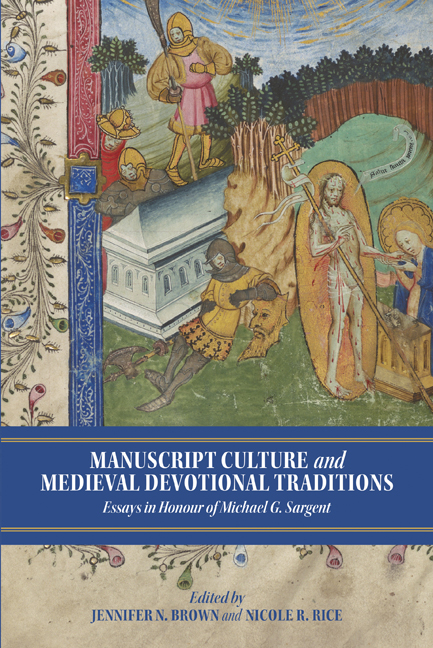Book contents
- Frontmatter
- Dedication
- Contntes
- List of Illustrations
- Acknowledgements
- List of Abbreviations
- Michael Sargent: An Appreciation
- I Manuscript Transmission and Textual Adaptation
- II Translated Texts and Devotional Implications
- III Rhetorical Strategies and Spiritual Transformations
- IV Texts and Contours of Religious Life
- Bibliography
- List of Contributors
- Michael G. Sargent’s Publications
- Index
- Tabula Gratulatoria
- York Manuscript and Early Print Studies
13 - The Body of the Nun and the Syon Abbey ‘Additions’
Published online by Cambridge University Press: 24 March 2021
- Frontmatter
- Dedication
- Contntes
- List of Illustrations
- Acknowledgements
- List of Abbreviations
- Michael Sargent: An Appreciation
- I Manuscript Transmission and Textual Adaptation
- II Translated Texts and Devotional Implications
- III Rhetorical Strategies and Spiritual Transformations
- IV Texts and Contours of Religious Life
- Bibliography
- List of Contributors
- Michael G. Sargent’s Publications
- Index
- Tabula Gratulatoria
- York Manuscript and Early Print Studies
Summary
Bridget's vision, Syon Abbey and double monasteries in England
In this essay I will look at how Syon Abbey served as a site of religious questions and problems concerning orthodoxy and gender in medieval England and examine the ways in which the abbey's legislative texts reinforced ambiguous gender binaries and representations within the order's double structure. At the centre of these conflicts, anxieties and disputes stood the body of the nun. Her description, along with the limits of her agency and the transgressions she has the potential to commit are the issues to which the abbey's texts returned. Within the double order, the nuns’ bodies are brought into relief against the backdrop of the men; the presence of the brothers focuses the gaze on the sexualized bodies of the nuns in ways that a standard female-only convent would not permit. The Syon ‘Additions’, a set of legislative supplements to the general Birgittine rule, offer a particular insight into the way that the order in England embraced and struggled with the double monastic structure. The body of the Syon nun lay at the core of this struggle.
Bridget did not plan for an order of nuns in the usual way – founding a house, following an established rule, finding Church and state support. Instead, Bridget had a revelation of what her order and rule would look like, and it was unlike other established orders. Bridget's vision decreed a house of sixty nuns, with a delineated group of brothers to assist them: thirteen priests, four deacons and eight lay brothers. This was one of Bridget's most notable departures from other houses, even those with a double monastic structure. Here, Bridget envisioned brothers living and serving under the abbess, the ultimate authority of the house, and she saw the Birgittine brothers (technically not monks) as supporting what was, at its core, a house for women. The brothers, like the sisters, vowed to follow her rule, which she conceived in the visions; however, it did not officially become codified the way she imagined and was interpolated into the Augustinian rule when ultimately implemented. In 1346 the mother house was founded by Bridget in Vadstena, Sweden. Bridget conceived that only the sisters would elect the abbess, who would also lead the brothers.
- Type
- Chapter
- Information
- Manuscript Culture and Medieval Devotional TraditionsEssays in Honour of Michael G. Sargent, pp. 290 - 309Publisher: Boydell & BrewerPrint publication year: 2021

